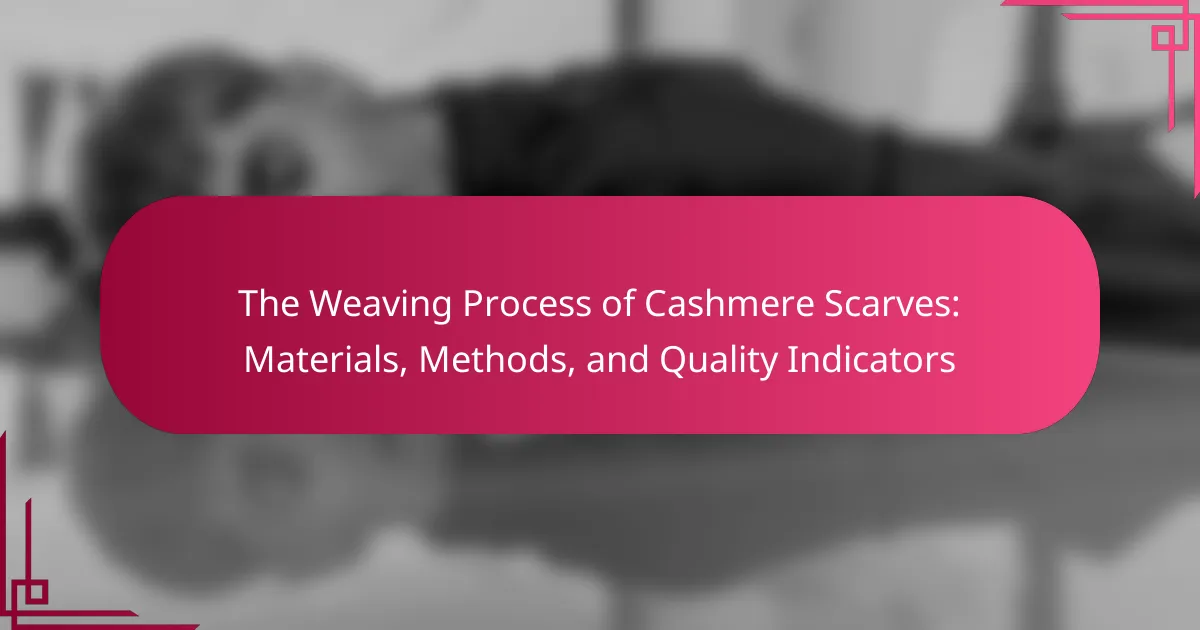The article focuses on the weaving process of cashmere scarves, detailing the essential materials, methods, and quality indicators involved. It begins with the sourcing of high-quality cashmere fibers from cashmere goats, which are then cleaned, sorted, and spun into yarn. The dyed yarn is woven using traditional looms, employing techniques such as hand weaving and machine weaving to create various patterns. The finishing processes, including washing and pressing, enhance the scarves’ quality, while inspections ensure that only the best products reach consumers. The article emphasizes the importance of craftsmanship and material quality in producing luxurious cashmere scarves.

What is the weaving process of cashmere scarves?
The weaving process of cashmere scarves involves several key steps. First, high-quality cashmere fibers are sourced from cashmere goats. These fibers are then cleaned and sorted based on their fineness. After sorting, the fibers are spun into yarn. This yarn is then dyed using various techniques to achieve desired colors.
Next, the dyed yarn is woven using traditional looms. Weaving can be done in different patterns, such as plain weave or twill weave. After weaving, the scarves undergo finishing processes. These processes may include washing, pressing, and trimming to ensure quality.
Finally, the finished cashmere scarves are inspected for quality and packaged for sale. The entire process emphasizes craftsmanship and attention to detail, which contributes to the luxurious feel of cashmere scarves.
How is cashmere sourced for scarf production?
Cashmere is sourced for scarf production primarily from the undercoat of cashmere goats. These goats are typically found in cold regions, such as Mongolia and China. The cashmere is collected during the molting season, which occurs in spring. Farmers comb the goats to gather the soft, fine fibers that shed naturally. This process is labor-intensive and requires skilled handling to ensure fiber quality. Each goat produces about 150 grams of cashmere annually. The collected fibers are then cleaned and sorted based on quality and length. High-quality cashmere is selected for scarf production due to its softness and warmth.
What are the characteristics of high-quality cashmere?
High-quality cashmere is characterized by its softness, warmth, and durability. It has a fine, lightweight texture that feels luxurious against the skin. The fibers are longer and finer than lower-quality cashmere, typically measuring around 14-19 microns in diameter. High-quality cashmere also possesses excellent insulation properties, providing warmth without bulk. Its natural elasticity allows it to retain shape over time. Additionally, high-quality cashmere has a rich, vibrant color that remains consistent after washing. The sourcing of cashmere from reputable suppliers contributes to its overall quality. Cashmere from the Changthangi goat, found in the Himalayan region, is often regarded as the finest.
How does the sourcing location affect cashmere quality?
The sourcing location significantly affects cashmere quality. Cashmere from regions with harsh climates, such as Mongolia and Tibet, tends to be finer and softer. These areas have extreme temperatures that promote the growth of high-quality undercoat fibers. The cashmere goats in these regions produce a thicker undercoat to insulate themselves. This results in cashmere that is warmer and more durable. Additionally, the traditional herding practices in these locations contribute to the quality of the fibers. The unique environmental conditions and local practices create a distinct quality in the cashmere produced.
What are the key steps in the weaving process?
The key steps in the weaving process include preparing the yarn, setting up the loom, weaving the fabric, and finishing the product. First, yarn is selected and prepared for weaving. This involves cleaning, spinning, and dyeing the cashmere fibers. Next, the loom is set up with the warp threads, which run lengthwise. After setup, the actual weaving begins, where the weft threads are interlaced with the warp. Finally, the woven fabric is finished through processes like washing, drying, and pressing to enhance its quality. Each step is crucial for producing high-quality cashmere scarves.
How is cashmere prepared before weaving?
Cashmere is prepared for weaving through a meticulous process that ensures high quality. First, cashmere fibers are sheared from goats during the molting season. Next, the fibers undergo a cleaning process to remove dirt and grease. This is typically done using gentle washing techniques. After cleaning, the fibers are sorted based on length and quality. Higher quality fibers are separated for premium products. Following sorting, the fibers are carded to align them and remove any remaining impurities. Finally, the prepared fibers are spun into yarn, ready for weaving. This preparation process is crucial for achieving the softness and durability associated with cashmere.
What weaving techniques are commonly used for cashmere scarves?
Common weaving techniques used for cashmere scarves include plain weave, twill weave, and jacquard weave. Plain weave offers a simple, flat texture, making it ideal for lightweight scarves. Twill weave creates a diagonal pattern, providing a more textured and durable fabric. Jacquard weave allows for intricate designs and patterns, enhancing the visual appeal of the scarf. These techniques are essential for achieving the desired softness and drape of cashmere. Each method contributes to the overall quality and aesthetic of the final product.
What factors influence the quality of cashmere scarves?
The quality of cashmere scarves is influenced by several key factors. The source of cashmere fibers is critical; high-quality cashmere comes from the undercoat of cashmere goats during molting season. The fiber’s diameter affects softness; finer fibers typically result in a softer and more luxurious feel. The length of the fibers also matters; longer fibers create a stronger and more durable scarf.
The processing methods play a significant role as well. Proper washing and dehairing techniques preserve the integrity of the fibers. Additionally, the dyeing process can impact the overall quality; natural dyes are often preferred for their gentleness on fibers. The weaving technique used, such as twill or plain weave, influences the texture and durability of the scarf.
Finally, the finishing treatments applied after weaving can enhance the softness and appearance of the cashmere. All these factors combined determine the overall quality and desirability of cashmere scarves.
How do different weaving patterns impact durability?
Different weaving patterns significantly impact the durability of cashmere scarves. Tighter weaves generally enhance durability by creating a denser fabric that withstands wear and tear. For example, twill patterns are known for their strength and resistance to fraying. In contrast, looser weaves may result in a softer feel but can lead to quicker degradation over time. Research indicates that fabrics woven with a higher thread count exhibit greater longevity due to reduced strain on individual fibers. Additionally, patterns like satin can provide a smooth finish but may compromise durability compared to more robust weaves. Thus, the choice of weaving pattern plays a crucial role in the overall lifespan of cashmere scarves.
What role does finishing play in the quality of cashmere scarves?
Finishing plays a crucial role in the quality of cashmere scarves. It enhances the softness, drape, and overall appearance of the fabric. Finishing processes can include washing, brushing, and steaming. These processes remove impurities and improve the texture. High-quality finishing results in a luxurious feel against the skin. Additionally, it can help to reduce pilling and increase durability. The final finish contributes to the scarf’s aesthetic appeal. Therefore, effective finishing is essential for premium cashmere products.

What materials are essential in cashmere scarf production?
Cashmere scarf production primarily requires cashmere fibers. These fibers are sourced from the undercoat of cashmere goats. The quality of the fibers is crucial for softness and warmth. Additional materials include dyes for color and finishing agents for texture. Weaving techniques utilize looms to create the fabric structure. The final product often incorporates fringe or borders for aesthetic appeal. Each material contributes to the overall quality and feel of the scarf.
What are the primary raw materials used in cashmere scarves?
The primary raw materials used in cashmere scarves are cashmere fibers, silk, and wool. Cashmere fibers are obtained from the undercoat of cashmere goats. These fibers are known for their softness and warmth. Silk is sometimes blended with cashmere to enhance sheen and durability. Wool can also be included to add strength and resilience. The quality of cashmere is determined by the fineness and length of the fibers. High-quality cashmere comes from regions like Mongolia and China, where the climate contributes to superior fiber quality.
How do dyes and treatments affect the final product?
Dyes and treatments significantly influence the final product of cashmere scarves. The choice of dye affects color vibrancy and longevity. Natural dyes often yield softer hues, while synthetic dyes provide brighter, more saturated colors. Treatments such as washing and finishing enhance the texture and softness of cashmere. These processes can also impact durability and resistance to pilling. For instance, mercerization can improve luster and strength. The final appearance and feel of the scarf depend on the specific dyes and treatments used. Thus, the selection of these elements is crucial for achieving desired quality in cashmere scarves.
What alternatives to cashmere are available in scarf production?
Alternatives to cashmere in scarf production include merino wool, alpaca fiber, and synthetic materials. Merino wool is known for its softness and breathability. Alpaca fiber offers warmth and is hypoallergenic. Synthetic materials, such as polyester and acrylic, provide durability and are often more affordable. These alternatives cater to various consumer preferences, including ethical sourcing and cost-effectiveness. Each option has unique properties that make them suitable for scarf production.
How do different materials affect the characteristics of cashmere scarves?
Different materials significantly affect the characteristics of cashmere scarves. The blend of cashmere with other fibers alters texture, warmth, and durability. For example, adding silk enhances sheen and drape while maintaining softness. Blending with wool increases warmth and resilience but may reduce cashmere’s softness. Cotton blends offer breathability but can diminish the luxurious feel. Synthetic fibers can enhance durability but may compromise the natural qualities of cashmere. The specific ratios of these materials determine the final product’s quality and performance. Overall, the choice of materials directly influences the scarf’s aesthetic and functional properties.
What is the impact of blend ratios on texture and warmth?
Blend ratios significantly impact the texture and warmth of cashmere scarves. A higher percentage of cashmere in the blend typically results in a softer and warmer texture. For instance, a 100% cashmere scarf feels luxurious and retains heat effectively. In contrast, blends with synthetic fibers may reduce warmth and alter the texture, making it less soft. Research indicates that a blend ratio of 70% cashmere to 30% wool offers a balance of warmth and durability while maintaining a pleasant texture. The choice of blend ratio directly influences the scarf’s overall quality and comfort.
How do synthetic fibers compare to natural cashmere?
Synthetic fibers differ significantly from natural cashmere in texture, warmth, and breathability. Cashmere is renowned for its softness and luxurious feel, derived from the undercoat of cashmere goats. In contrast, synthetic fibers like polyester or nylon can feel less soft and may not provide the same level of comfort.
Natural cashmere offers superior insulation, keeping the wearer warm without bulk. Synthetic fibers may trap heat but often lack the natural moisture-wicking properties found in cashmere. Cashmere is also breathable, allowing for better temperature regulation, while synthetic options can retain heat and moisture, leading to discomfort.
Durability is another point of comparison. Synthetic fibers are typically more resistant to wear and tear. However, cashmere, when properly cared for, can last a long time and develop a desirable patina.
Overall, while synthetic fibers may offer durability and cost-effectiveness, natural cashmere remains unmatched in luxury and comfort.

What methods are used in cashmere scarf weaving?
Cashmere scarf weaving primarily employs methods such as hand weaving and machine weaving. Hand weaving involves skilled artisans using traditional looms to create intricate patterns. This method allows for greater control over the quality and design of the scarf. Machine weaving, on the other hand, utilizes automated looms for faster production. This method is often more cost-effective and suitable for mass production. Both methods can produce high-quality cashmere scarves, but hand weaving is typically associated with luxury and craftsmanship. The choice of method influences the scarf’s texture, durability, and overall aesthetic appeal.
What traditional methods are still used today?
Traditional methods still used today in the weaving process of cashmere scarves include hand-spinning, hand-weaving, and natural dyeing. Hand-spinning involves artisans twisting cashmere fibers into yarn, preserving the fiber’s quality. Hand-weaving is done on traditional looms, allowing for intricate patterns and textures. Natural dyeing employs plant-based dyes, ensuring vibrant colors without synthetic chemicals. These methods have been practiced for centuries and are integral to maintaining the authenticity of cashmere products. Many artisans continue to use these techniques to produce high-quality, sustainable scarves.
How does hand-weaving differ from machine-weaving?
Hand-weaving differs from machine-weaving in the method and quality of the weaving process. Hand-weaving involves manual labor and craftsmanship, allowing for intricate designs and unique textures. This method often results in a higher quality fabric with personalized details. In contrast, machine-weaving utilizes automated processes for speed and efficiency. Machine-woven fabrics are typically uniform and consistent but may lack the unique characteristics of hand-woven textiles. Historical evidence shows that hand-woven items have been valued for their artisanal quality, while machine-woven fabrics became prevalent during the Industrial Revolution for mass production.
What are the advantages of using traditional methods?
Traditional methods of weaving cashmere scarves offer several advantages. They ensure high craftsmanship quality. Artisans often possess generations of experience, leading to superior techniques. Traditional methods also utilize natural materials, enhancing the scarf’s texture and durability. The craftsmanship often results in unique designs that reflect cultural heritage. Additionally, these methods support local economies by preserving traditional skills. Historical evidence shows that handmade cashmere products maintain higher resale values compared to machine-made alternatives. Overall, traditional methods contribute to the authenticity and quality of cashmere scarves.
What modern techniques are transforming cashmere weaving?
Modern techniques transforming cashmere weaving include advanced machinery, digital design software, and sustainable practices. Advanced machinery enhances efficiency and precision in the weaving process. For instance, Jacquard looms allow intricate patterns to be woven with minimal manual intervention. Digital design software enables designers to create complex patterns and visualize them before production. This reduces errors and streamlines the design process. Sustainable practices, such as eco-friendly dyeing methods, are also being adopted. These practices minimize environmental impact while maintaining the quality of cashmere. Together, these techniques improve the overall quality and sustainability of cashmere products.
How has technology improved efficiency in scarf production?
Technology has improved efficiency in scarf production through automation and advanced machinery. Automated looms increase production speed and precision. Digital knitting machines allow for complex designs without manual intervention. Computer-aided design (CAD) software streamlines the design process. This reduces the time from concept to finished product. Furthermore, real-time monitoring systems enhance quality control. They minimize defects and waste during production. Overall, these technological advancements significantly boost output and reduce labor costs.
What innovations are enhancing the quality of cashmere scarves?
Innovations enhancing the quality of cashmere scarves include advanced spinning techniques and improved fiber processing methods. These techniques reduce the presence of coarse fibers, resulting in a smoother texture. Additionally, innovations in dyeing technology allow for more vibrant colors without compromising fiber integrity. Sustainable practices, such as eco-friendly sourcing and production, also contribute to higher quality. Recent advancements in quality control use digital tools to monitor fiber strength and consistency. These innovations collectively elevate the overall quality of cashmere scarves, ensuring durability and luxury in the final product.
What are the best practices for maintaining cashmere scarf quality?
To maintain cashmere scarf quality, proper care is essential. Hand wash cashmere in cold water using a gentle detergent. Avoid wringing or twisting the fabric to prevent damage. Lay the scarf flat on a clean towel to dry, away from direct sunlight. Store cashmere scarves folded in a cool, dry place. Avoid hanging, as this can stretch the fibers. Regularly de-pill using a cashmere comb to keep the surface smooth. Protect cashmere from moths by using lavender sachets or cedar blocks. Following these practices helps preserve the softness and longevity of cashmere scarves.
How should cashmere scarves be washed and stored?
Cashmere scarves should be washed gently by hand in cold water with a mild detergent. Avoid using hot water or harsh chemicals, as they can damage the fibers. After washing, rinse the scarf thoroughly to remove all soap. Do not wring or twist the scarf; instead, press it gently between two towels to remove excess water.
For storage, lay the scarf flat in a cool, dry place. Avoid hanging it, as this can stretch the fabric. Store it in a breathable cotton bag to protect it from dust and moths. Keeping cashmere scarves away from direct sunlight helps prevent fading. Proper care maintains the softness and quality of cashmere.
What tips can help preserve the softness and longevity of cashmere scarves?
To preserve the softness and longevity of cashmere scarves, proper care is essential. Hand washing in cold water with a gentle detergent is recommended. Avoid using hot water or harsh chemicals, as these can damage the fibers. After washing, lay the scarf flat on a clean towel to dry, avoiding direct sunlight. Storing cashmere scarves folded in a breathable cotton bag prevents stretching and protects against moths. Regularly de-pilling with a cashmere comb maintains the fabric’s smooth texture. Following these guidelines ensures that cashmere scarves remain soft and last longer.
The main entity of the article is the weaving process of cashmere scarves, which encompasses the sourcing, preparation, and production of high-quality cashmere. The article outlines the meticulous steps involved in weaving cashmere scarves, including fiber collection from cashmere goats, spinning, dyeing, and various weaving techniques such as plain, twill, and jacquard. It also discusses the impact of sourcing locations on cashmere quality, the importance of finishing processes, and the role of materials in determining the characteristics of the final product. Additionally, it highlights best practices for maintaining the quality and longevity of cashmere scarves.
